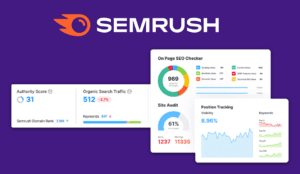Welcome to the world of Semrush, your ultimate toolkit for digital marketing success! Whether you’re a newbie or a seasoned pro, this guide will walk you through everything you need to know to harness the full potential of Semrush. Ready to dive in? Let’s get started!

Beginner’s Guide: Setting the Foundation
Step 1: Create Your Account
- Visit the Semrush website: Head over to Semrush.com and sign up for a free trial or choose a plan that suits your needs.
- Set up your profile: Fill in your business details and areas of interest to customize your experience.
Step 2: Dashboard Navigation
- Explore the dashboard: Familiarize yourself with the layout. Key sections include SEO, Advertising, Social Media, Content Marketing, and Competitive Research.
- Customize your workspace: Add widgets and shortcuts to frequently used tools.
Step 3: Basic Keyword Research

- Keyword Overview: Enter a keyword in the search bar to get an overview of its search volume, difficulty, and trends.
- Related Keywords: Discover related keywords and questions to expand your strategy.
Step 4: Site Audit

- Run a site audit: Navigate to the ‘Site Audit’ tool and enter your website URL. This will scan your site for technical issues affecting SEO.
- Review the report: Fix high-priority issues first, like broken links, duplicate content, and missing meta tags.
Step 5: Competitor Analysis

- Domain Overview: Enter a competitor’s domain to see their traffic stats, top keywords, and backlinks.
- Gap Analysis: Identify keywords your competitors rank for that you don’t, giving you new opportunities.
Intermediate Guide: Building Your Strategy
Step 6: Advanced Keyword Research
- Keyword Magic Tool: Use this tool to find long-tail keywords and group them by topics.
- Keyword Difficulty: Prioritize keywords with a balance of high search volume and low difficulty.
Step 7: On-Page SEO Checker
- Optimize existing content: Enter your target keywords and URL to get specific recommendations for improving on-page SEO.
- Track progress: Use the ‘SEO Writing Assistant’ to ensure your content meets SEO guidelines as you write.
Step 8: Backlink Building
- Backlink Analytics: Analyze your backlink profile and identify toxic links to disavow.
- Backlink Gap: Find backlink opportunities by comparing your link profile with competitors.
Step 9: Content Marketing
- Topic Research: Discover trending topics and popular headlines to inspire your content creation.
- Content Analyzer: Track the performance of your content across the web, identifying top-performing pieces and areas for improvement.
Step 10: Social Media Toolkit
- Schedule and post: Plan your social media posts in advance and automate publishing.
- Analyze performance: Track engagement metrics and adjust your strategy based on data insights.
Advanced Guide: Mastering the Toolkit
Step 11: PPC Advertising
- Advertising Toolkit: Research keywords for your PPC campaigns, analyze competitor ads, and track your ad performance.
- Ad Builder: Create compelling ad copy with suggestions based on best practices.
Step 12: Market Explorer
- Industry Analysis: Enter your industry or competitors to see market trends, audience demographics, and growth opportunities.
- Traffic Analytics: Deep dive into competitors’ website traffic sources, user behavior, and top pages.
Step 13: Brand Monitoring
- Set up alerts: Monitor your brand mentions across the web and social media.
- Analyze sentiment: Understand the tone of conversations about your brand and adjust your PR strategy accordingly.
Step 14: Reporting and Analytics
- Custom Reports: Create white-label reports for clients with your logo and branding.
- Automated Reporting: Schedule regular reports to keep stakeholders updated on progress.
Step 15: API Integration
- Integrate Semrush API: Use the API to pull data directly into your own tools and dashboards.
- Automate workflows: Streamline your processes by automating data retrieval and analysis.
Pro Tips and Tricks
- Regular Audits: Schedule monthly site audits to stay on top of technical issues.
- Competitor Watch: Set up competitor tracking to receive updates on their activities and strategies.
- Content Calendar: Use the content marketing toolkit to plan your editorial calendar around key dates and trends.
- A/B Testing: Continuously test different keywords, ad copies, and social media posts to find the best-performing versions.
- Stay Updated: Semrush frequently updates its tools and features. Keep an eye on their blog and webinars for the latest tips.
What we learned so far…..
Semrush is a powerhouse that can transform your digital marketing efforts from basic to advanced. By following this step-by-step guide, you’ll be able to leverage its tools effectively to boost your SEO, PPC, content marketing, and more. So, what are you waiting for? Start exploring Semrush today and watch your online presence soar!



